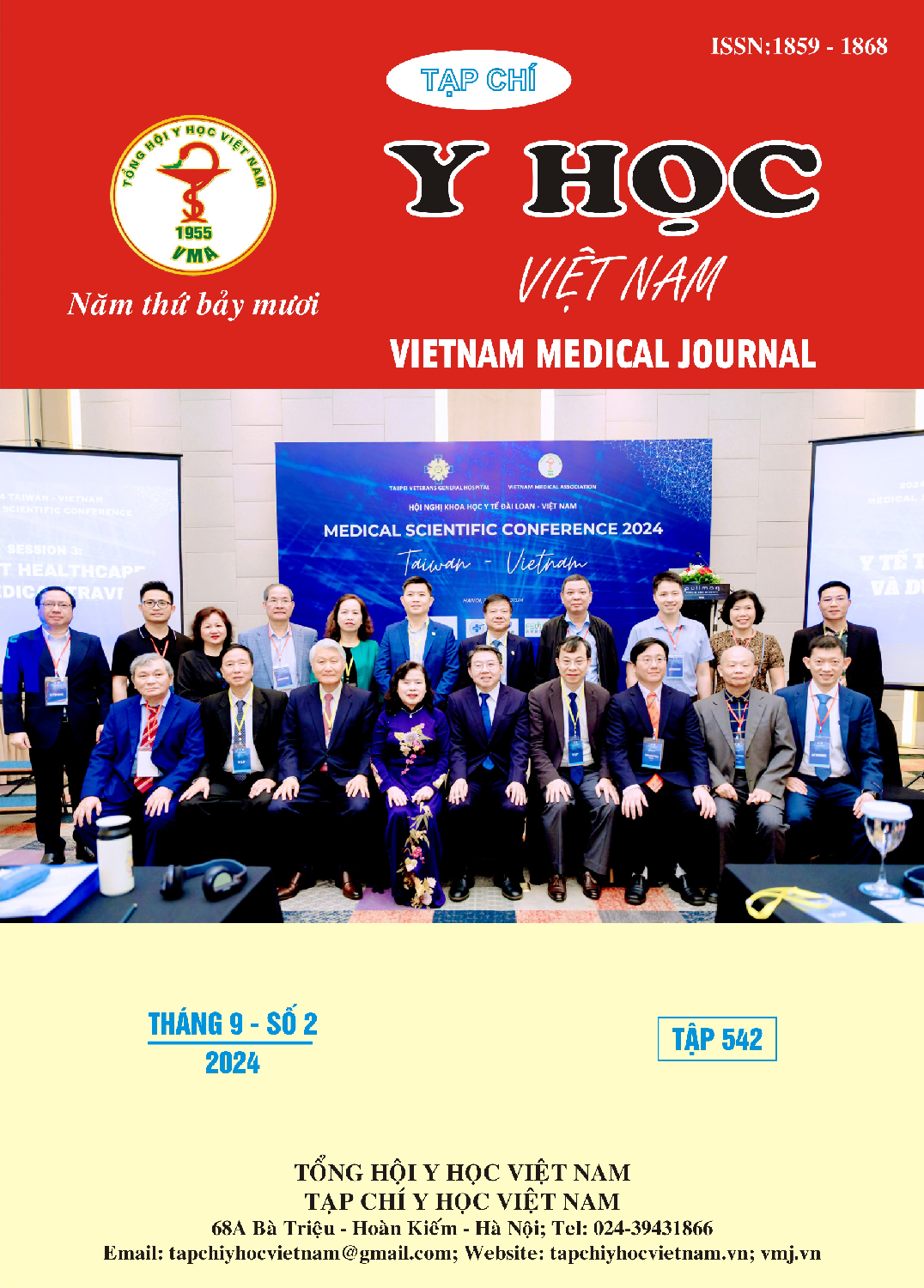CLINICAL CHARACTERISTICS AND RISK FACTORS FOR ANTIBIOTIC ASSOCIATED DIARHEA IN CHILDREN AT THE THAI BINH PEDIATRIC HOSPITAL
Main Article Content
Abstract
Antibiotic-associated diarrhea (AAD) is defined as unexplained diarrhea that occurs in association with antibiotic therapy. It may occur just a few hours after antibiotic administration or up to 8 weeks after the discontinuation of antibiotics. Many cases of AAD are mild and self-limiting, but they may cause severe electrolyte/fluid imbalance, hospital readmissions and pseudomembranous colitis caused by C.difficile. Aim: To evaluate the incidence, clinical findings, and risk factors of antibiotic-associated diarrhea in hospitalized children at the Respiratory Department of Thai Binh Pediatric Hospital. Materials and methods: Prospective descriptive study of a series of 219 cases diagnosed antibiotic- associated diarrhea during treatment at the Respiratory Department of Thai Binh Pediatric Hospital from August 2023 until April 2024. Results: During hospitalization, diarrhea developed in 219 (5,1%) of the 4312 children. The boy/girl ratio is 1,6:1. The highest incidence was in children the 6 months to 24 months of age group with a rate of 52,5%. The mean onset was 3,1 ± 2,1 days, and 95% of children developed diarrhea within 7 days after using antibiotics. 96,8% of children had mild to moderate diarrhea. 76,2% of children had watery stools, rates of mucus and bloody stools were 22,4% and 1,4%, respectively. The most common accompanying symptom was vomiting (48,4%); poor appetite (40,4%) and fever (22,4%); 72,6% of children had no dehydration. The rates of elevated white blood cells and CRP were 50,1% and 35,2%, respectively. The prevalence of sodium and potassium electrolyte disorders was 3,6% and 2,8%, respectively. Stool analysis showed the rates of white blood cells and red blood cells were 6,8% and 1,4%, respectively; Up to 56,6% of children tested had fat particles in their stools. Some risk factors in the study include children ≤ 24 months, OR = 3,6 (2,4 – 5,4); long hospital stay more than 7 days, OR = 7,6 (5,6 – 10,3); history of antibiotic-associated diarrhea, OR = 2,7 (1,9 - 3,8), and history of hospitalization within the prior 12 weeks, OR = 2,7 (1,9 - 3,7). Conclusion: The incidence of AAD is low among hospitalized children and common in children ≤ 24 months of age. Most of diarrheal episodes are mild to moderate severity and self-limiting. Risk factors of antibiotic-associated diarrhea are infants ≤ 24 months of age, prolonged hospital stay, history of ADD, and history of hospitalization within the prior 12 weeks.
Article Details
Keywords
Clinical, laboratoty, antibiotics, antibiotic-associated diarrhea, children, diarrhea, risk factors
References
2. McFarland LV, Ozen M, Dinleyici EC, Goh S. Comparison of pediatric and adult antibiotic-associated diarrhea and Clostridium difficile infections. World J Gastroenterol. 2016; 22(11):3078-3104. doi:10.3748/wjg.v22.i11.3078
3. Pant C, Deshpande A, Altaf MA, et al. Clostridium difficile infection in children: a comprehensive review. Curr Med Res Opin. 2013;29(8): 967-984. doi:10.1185/03007995. 2013.803058
4. Wistrom J. Frequency of antibiotic-associated diarrhoea in 2462 antibiotic-treated hospitalized patients: a prospective study. J Antimicrob Chemother. 2001;47(1):43-50. doi:10.1093/ jac/47.1.43
5. Phạm Thị Lam Liên, Nguyễn Thị Việt Hà. Tiêu chảy liên quan đến kháng sinh ở trẻ em tại khoa Nhi Bệnh viện đa khoa Đức Giang. Tạp Chí Học Thực Hành 1104. August 2019:53-55.
6. Nguyễn Xuân Thanh. Đặc điểm dịch tễ học lâm sàng và một số yếu tố liên quan đến tiêu chảy khi sử dụng kháng sinh ở trẻ em dưới 6 tuổi tại Bệnh viện Nhi Trung Ương. Trường Đại học Y dược Hải Phòng. 2018.
7. McFarland LV. Epidemiology, Risk Factors and Treatments for Antibiotic-Associated Diarrhea. Dig Dis. 1998;16(5):292-307. doi:10.1159/000016879
8. Mullish BH, Williams HR. Clostridium difficile infection and antibiotic-associated diarrhoea. Clin Med Lond Engl. 2018;18(3):237-241. doi:10. 7861/clinmedicine.18-3-237
9. Gibson MK, Crofts TS, Dantas G. Antibiotics and the developing infant gut microbiota and resistome. Curr Opin Microbiol. 2015;27:51-56. doi:10.1016/j.mib.2015.07.007


